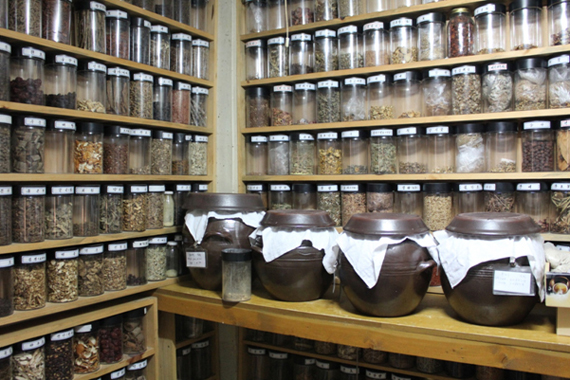 |
||
| ▲ There are many kinds of traditional alcohols. (Google) | ||
Which alcohol do you like the most? In bars and restaurants, the types of alcohol vary from soju to liquor. This spring saw the launch of a new craze among booze drinkers when fruit flavored soju was launched. People prefer drinking the flavored soju because of the low-alcohol percentage and the sweet taste. However even before the release of these fruit-flavored sojus, Koreans had a taste for this kind of sweeter booze as they had a traditional wine made with real fruits such as omija, plum, and tangerine. Where did our knowledge of alcohol production come from and what kinds of booze have we made and continue to make today?
The origin of alcohol production is presumed to have started in primitive times. We don’t know exactly when our ancestors started to make and drink alcohol, however the first written record of booze can be found in the ancient ‘Three States Volume’. With the text contained in this historical book we can estimate that Koreans made and drank alcohol during the period of the Three States which is around 40 B.C..
Having this long tradition of booze in our country the DKH wondered, how many different kinds of traditional alcohol exists and what exactly are they? We learned there are about 2,000 different types of Korean traditional alcohol. Traditional alcohols have a long history and are protected as an intangible cultural asset.
The Dankook Herald (DKH) looked into the types of alcohols we produce and the regions they are associated with. The west has been developing fruit-based alcohol from grapes, while the east has been developing grain-based booze from things like rice. ‘Cheongju’ and ‘Takju’ were the most prominent drinks of choice with our ancestors and they are a refined rice wine and an unrefined rice wine.
Takju is the oldest form alcohol manufactured in Korea. Regardless of the percentage of alcohol content, Takju is blurry and muddy. Makgeolli for instance, is made by diluting the water from Takju. Takju is enjoyed by people from all walks of life, from ordinary citizens to the upper class.
Unlike Takju, the color of Cheongju is clear, and Cheongju doesn’t have any solids. Cheongju has a special smell and taste. Moreover, people sometimes drink it when they mark memorial services or host ceremonial events. Also, it is made
from the traditional ‘nuruk’, a Korean rice-wine.
‘Soju’ is also a traditional alcohol. Lately, people have argued it has its origins in the Yuan Dynasty. After completing some research regarding Soju on the Internet, the DKH discovered it is easy to find information regarding the origins of Andong Soju. When people make Soju, they use distillation techniques. The origin of these distillation techniques can be traced back to the Arab region.
According to an Arab merchant, Soju was brought to Asia in the 12th century. By the end of 13th Yuan Dynasty, it was the Joseon Dynasty army that brought Soju to Korea. In the process, the distillation techniques that make Soju were transferred to Korea.
There are 8 regions in Korea, and each region has their traditional alcohol. First, the traditional alcohol of Seoul is ‘Samhaeju’ which is made with non-glutinous rice, glutinous rice and nuruk. ‘Munbaeju’ is the representative alcohol for the Gyeonggi-do region. Gangwon-do’s traditional alcohol is ‘Sunju’ which is made with potatoes and corn. ‘Omegi’ is the traditional alcohol of Jeju Island and it is made from the Omegil rice cake. In addition to these types of alcohol, there is also ‘Andong soju’, ‘Songsunju’, ‘Hongju’ and many others.
To know more about our booze-making history, the DKH interviewed Jo Tae-gyeong (member of Korea Traditional Alcohol Institute). She said, “I think we have to think about which kinds of alcohol should be considered as the real traditional beverage, before we start talking about traditional alcohol. Under the Alcohol Tax Law, traditional booze is two things. One is alcohol that is considered an intangible cultural asset and called ‘National Alcohol’. The other one is alcohol made by food masters called a ‘Local Special Product’. The difference is that traditional alcohol is made with traditional yeast using domestic agricultural products.”
The DKH also asked about the characteristics and merits of Korea traditional alcohol. “The characteristics of it are its different flavors and scenes. These are rooted in our method of fermentation and the materials we use. Traditional alcohol in Korea is the alcohol made by rice which is a staple food of Koreans. Also, the materials used have no artificial flavor. Most of them are rooted from the nature,” she said. “As compared to the alcohol of Japan and China, the traditional alcohol of Korea takes a longer time to ferment and mature,” she explained.
Finally, the DKH asked how we can introduce our traditional alcohol to the world. “In order to popularize Korea’s traditional alcohol, it is important to first establish our identity as a unique brewing nation,” she said.
Above all, establishing a unique identity of traditional alcohol is important. First, when brewers make traditional alcohol, brewers should follow traditional and inherent methods. Second, we need to develop our skills for preserving flavor and lastly, we need the support from the government and other authorities to popularize our products globally.
When we meet friends or acquaintances, the right amount of alcohol could make equally good company. There are many kinds of alcohol that are produced in Korea. The DKH recommends Dankookians to get to know the origins and characteristics of their alcohol of choice, before you drink. It will help you to enjoy a more pleasant drinking culture.
An Hee-jin, Lee Hun-ki anhj12261226@gmail.com

![[Campus Magnifier] Let's Surf the Library!](/news/photo/202404/12496_1765_4143.jpg) [Campus Magnifier] Let's Surf the Library!
[Campus Magnifier] Let's Surf the Library!
![[Campus Magnifier] Let's Surf the Library!](/news/thumbnail/202404/12496_1765_4143_v150.jpg)





